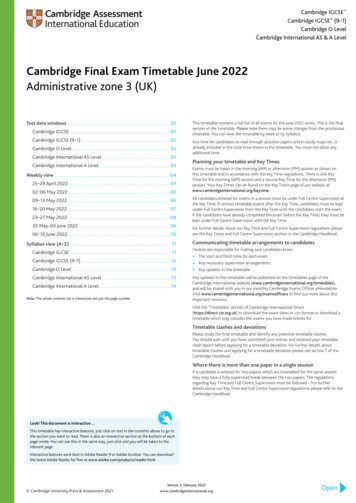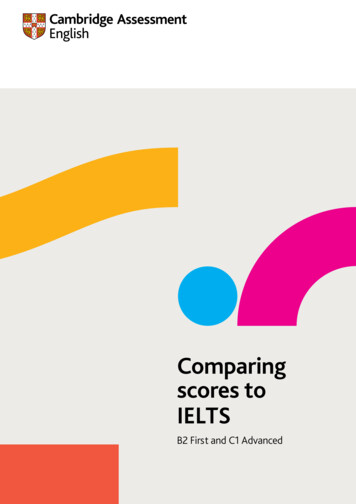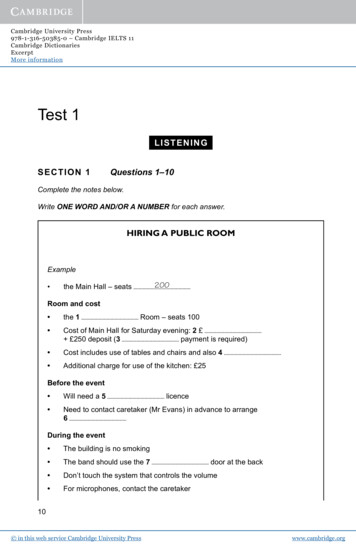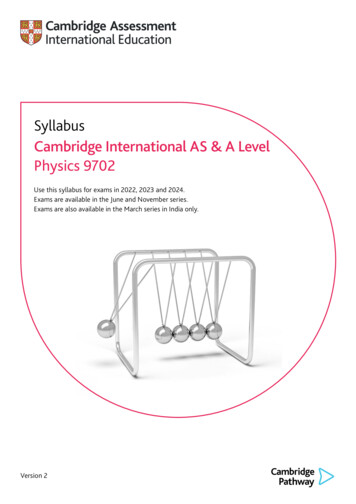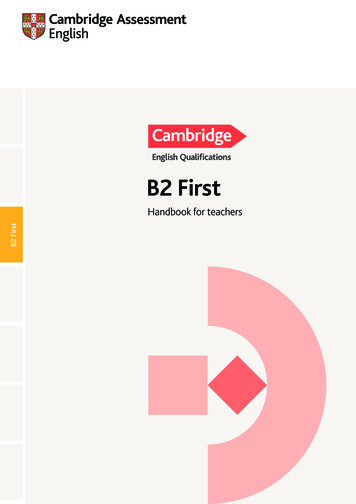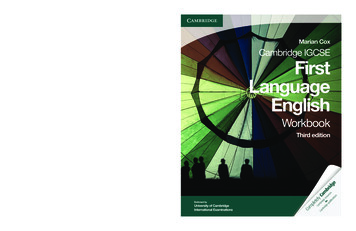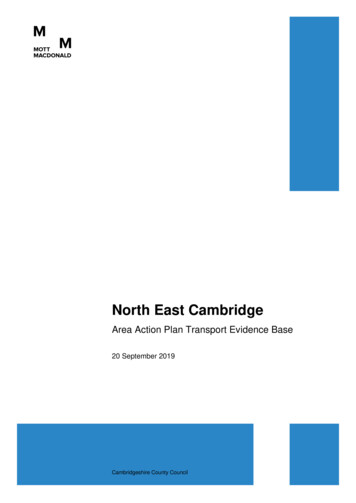
Transcription
North East CambridgeArea Action Plan Transport Evidence Base20 September 2019Cambridgeshire County Council
Mott MacDonald10 Fleet PlaceLondon EC4M 7RBUnited KingdomT 44 (0)20 7651 0300F 44 (0)20 7248 2698mottmac.comCambridgeshire CountyCouncilShire HallCastle HillCambridge CB3 0APNorth East Cambridge4032461Mott MacDonald20 September 2019Mott MacDonald Limited. Registered inEngland and Wales no. 1243967.Registered office: Mott MacDonald House,8-10 Sydenham Road, Croydon CR0 2EE,United 198/Do/Develop/40 Reports/Final Issue V1 Area ActionPlan Transport Evidence Base20.09.19/CNF (NEC) AAP TSR-Final Issue V1-20.09.19.docxCambridgeshire County Council
Mott MacDonald North East CambridgeArea Action Plan Transport Evidence BaseIssue and Revision keSalterJonathanCrabbDraft issue (Sections 1 to 4) forproject team review Calvo/MikeSalterJonathanCrabbDraft issue (Section 5) forproject team review Calvo/MikeSalterJonathanCrabbDraft issue (Section 6) forproject team review Calvo/MikeSalterJonathanCrabbDraft issue (Section 7) forproject team review Calvo/MikeSalterJonathanCrabbDraft issue (Section 8) forproject team review Calvo/MikeSalterJonathanCrabbDraft issue (Sections 9-11 &Exec Summary) for project teamreview and vo/MikeSalterJonathanCrabbSecond draft issue (Sections 1to 5) addressing project teamcomments for review / o/MikeSalterJonathanCrabb/MikeSalterSecond full draft issueaddressing project teamcomments for final review vo/MikeSalterJonathanCrabb/MikeSalterFinal ikeSalterJonathanCrabb/MikeSalterFinal issue V1Document reference: 403246 1 JInformation class: StandardThis document is issued for the party which commissioned it and for specific purposes connected with the abovecaptioned project only. It should not be relied upon by any other party or used for any other purpose.We accept no responsibility for the consequences of this document being relied upon by any other party, or beingused for any other purpose, or containing any error or omission which is due to an error or omission in data suppliedto us by other parties.This document contains confidential information and proprietary intellectual property. It should not be shown to otherparties without consent from us and from the party which commissioned it.This R eport has been prepar ed sol ely for us e by the party w hich commissi oned it (the 'Client') in connection wi th the capti oned pr oject. It shoul d not be used for any other purpose. N o pers on other than the Client or any party w ho has expr essly agreed term s of reli ance with us (the 'Recipi ent(s)') may r ely on the conte nt, information or any views expr ess ed in the R eport. T his R eport is confi denti al and c ontains pr opri etary intell ectual pr operty and we ac cept no duty of car e, r esponsibility or li ability to any other recipi ent of this R eport. N o repr esentati on, w arr anty or undertaki ng, ex press or im plied, is made and no res ponsi bility or liability is ac cepted by us to any party other than the Client or any Reci pient(s), as to the acc uracy or com pleteness of th e i nformati on c ontai ned i n this R eport. F or the avoi danc e of doubt thi s Report does not i n any w ay pur port to i nclude any legal, ins uranc e or fi nanci al advic e or opi nion.We dis claim all and any liability w hether arising i n tort, contr act or otherwis e w hich we might otherwise have to any party o ther than the Cli ent or the Reci pient(s), in res pect of this Report, or any inform ation contained in it. W e acc ept no res ponsi bility for any error or omissi on in the Report w hich is due to an error or omissi on in data, i nformation or statements s upplied to us by other parti es i ncludi ng the Cli ent (the 'Data'). We hav e not independently v erified the D ata or otherwis e exami ned i t to determi ne the acc uracy, com pleteness, sufficiency for any purpose or feasi bility for any partic ular outc ome incl uding fi nanci al.Forec asts pres ented i n this docum ent w ere pr epared usi ng the Data and the Repor t is dependent or bas ed on the D ata. Inevitably, s om e of the ass umptions us ed to dev elop the for ecasts will not be realised and unantici pated ev ents and circumstanc es m ay occ ur. C onsequently, we do not guarantee or w arrant the conclusions c ontained in the R eport as ther e are lik ely to be differenc es betw een the forecas ts an d the actual res ults and those differ ences may be m aterial. While we c onsi der that the information and opini ons given in this R eport are s ound all parti es m ust rely on their ow n s kill and judgem ent when m aking us e of it.Information and opi nions ar e c urrent only as of the date of the Report and w e acc ept no res ponsi bility for updati ng such information or opi nion. It s houl d, therefor e, not be assum ed that any s uc h inform ati on or opi nion conti nues to be acc urate subs equent to the date of the Report. U nder no circum stanc es m ay this Report or any ex trac t or summ ary thereof be us ed i n c onnecti on with any public or priv ate s ec urities offeri ng incl udi ng any related m emor andum or pr os pec tus for any securiti es offering or stock exchange listi ng or announcem ent.By acc eptanc e of this Repor t y ou agree to be bound by this disclaim er. T his disclaim er and any iss ues, dis putes or cl aims arising out of or in c onnection wi th it (whether c ontractual or non-contractual i n natur e s uc h as cl aims i n tort, from br eac h of statute or regul ati on or otherwise) s hall be gov erned by, and co nstr ued i n acc ordance with, the law s of Engl and and W ales to the exclusion of all c onflict of l aws principles and r ules . All dis putes or claims arising out of or r elati ng to this discl aimer s hall be s u bjec t to the excl usive juris dicti on of the English and Welsh courts to w hich the parties irrev ocably submit.403246 1 J 20 September 2019
Mott MacDonald North East CambridgeArea Action Plan Transport Evidence ndDocument structureBaseline uctionBaseline land usesBaseline accessibilityBaseline air quality conditionsBaseline highways safety reviewBaseline travel behaviourBaseline context summaryFuture context473.13.23.33.43.54747506064IntroductionLand use developmentTransport network developmentTravel trends and technologies affecting future mobilityFuture context summaryPredicting development trip generation664.14.24.34.44.5IntroductionEmployment tripsResidential tripsDevelopment scenario trip generationDevelopment trip generation summary6666697071Establishing development trip troductionMethodologyModelling resultsQuantifying the external vehicular trip budgetHighway access implicationsDevelopment air quality implicationsDevelopment highway safety implicationsEstablishing development trip budget summaryManaging parking supply403246 1 J 20 September 201990
Mott MacDonald North East CambridgeArea Action Plan Transport Evidence Base6.16.26.36.46.56.67Encouraging internalisation7.17.27.37.47.58IntroductionImpact assessment approachImpact of encouraging internalisation of tripsImpact of maximising non-car mode useImpact of increasing non-car mode overlapImpact of increasing Park & Ride usageImpact of future travel trends and technologiesModal implications of mode-shift aspirationsEstimating mode shift impact summaryTrip budget delivery ng non-car accessibilityIncreasing non-car useIncreasing non-car accessibility summaryEstimating mode shift ouraging internalisation through development mixEncouraging internalisation through connectivityEncouraging internalisation through a spatial frameworkEncouraging internalisation summaryIncreasing non-car accessibility and use8.18.28.38.49IntroductionThe case for managing parkingWorkplace parking issuesResidential parking issuesMitigating parking displacementManaging parking supply summaryIntroductionRecommended measuresPhasing and implementationFunding considerationsMonitoring and evaluationDelivery Plan summarySummary and conclusionsAppendices403246 1 J 20 September 8160164
Mott MacDonald North East CambridgeArea Action Plan Transport Evidence BaseA.2017 base turning counts165B.TRICS data outputs167B.1B.2B.3B.4B.5C.LINSIG modelling resultsC.1C.2C.3D.B1 Business Park trip rate per jobB2 Industrial Estate trip rate per jobB1 Business Park trip rate per 100m2 GFAB2 Industrial Estate trip rate per 100m2 GFAC3 Mixed Private / Affordable Housing trip rates per dwelling2017 Base model results2031 With-Dev Business-as-Usual Do Minimum model results2031 With-Dev Trip-Budget Do Something model resultsInternalisation calculationsD.1D.2D.3TEMPRO-NTS SummaryResident to Work Related Trips - 2011 Census Data AnalysisAge by single year - 2011 Census Data and Calculations403246 1 J 20 September 2019167168169170171172172173178183183184185
Mott MacDonald North East CambridgeArea Action Plan Transport Evidence BaseExecutive summaryIntroduction and baseline contextCambridge City Council and South Cambridgeshire District Council, working withCambridgeshire County Council and Highways England, are jointly preparing anArea Action Plan (AAP) for the North East Cambridge (NEC) area. MottMacDonald has been commissioned by Cambridgeshire County Council (CCC)to prepare a Transport Evidence Base to inform the AAP.A review of baseline transport conditions in and around the study area shows thatNEC is already relatively well-connected to surrounding multi-modal networks,but the effectiveness of these connections is hampered by performancelimitations at peak times. Examples of these include highway congestion issuesat the Milton Interchange and on Milton Road; delays to vehicles departing areasof the site during the PM peak period; and overcrowding on busway and railservices.There are also some significant barriers to pedestrian and cycle movementswithin and around the study area, including those imposed by Milton Road, andsome of the intra-site boundaries including fencing around the CambridgeBusiness Park, which reduce the potential permeability for these modes, whileoptions for introducing new highway access points and/or increasing existinghighway network capacity, even if this were desirable, are also limited by thesame physical barriers and other constraints.In addition, a review of 2011 Census data shows that nearly half of employeestravelling to the study area have no public transport alternative from point-oforigin and that nearly 90% of these travel to the site by car. The fact that there iscurrently an over-abundance of free parking across the NEC site as a wholeexacerbates this situation and disincentivises use of public transport (PT) evenwhere it is available so that, overall, 71% of employees currently drive to the NECarea to work.Given the current lack of spare highway network capacity in and around the studyarea at peak times, the limited opportunities to increase this in future, theadditional pressure to be placed by other developments such as the New townNorth of Waterbeach and the lack of wider policy support for this, it will benecessary for any further development to be delivered in a way that does notresult in peak-period highway trip levels increasing above existing levels to theextent of creating a severe impact. Remaining within this ‘trip budget’ will requirethe relatively unconstrained car mode-share level of today to be significantlyreduced in future, an approach which is in line with that adopted by the Greater403246 1 J 20 September 20191
Mott MacDonald North East CambridgeArea Action Plan Transport Evidence Base2Cambridge Partnership who are promoting various transport interventions tosupport the growing Cambridge economy.Future contextThere are a number of land use schemes already consented for the study areawhich will increase employment levels at the NEC. The development scenariosbeing potentially considered for the emerging study area AAP involve a furthersignificant increase in employment levels, plus a mix of housing and ancillaryuses to maximise internalisation of trips and not contribute to further exceedinglocal highway capacity. These scenarios could result in an increase in jobs anddwellings of between 4,400 and 13,200 and 5,500 and 9,200 respectively, assummarised in the table below.Table ES1: Summary of dwelling and estimated B1/B2 jobs perdevelopment scenarioJobsDwellingsExistingHIF ScenarioOption1Option 2Option3Option 6,6507,6008,700Source: Project TeamA review of committed, planned or potential transport improvements in the areashow that, as a result of those schemes which include pedestrian, cycle andpublic transport improvements, accessibility to the study area by non-car modeswill improve in coming years, but that highway capacity improvements will berelatively minor, particularly to the south of the A14. This confirms the principlethat any future development growth in the study area should be delivered withoutany significant increase in development-related highway trips so that highwayimpacts can be minimised.A review of recent and future travel trends and emerging technologies alsosuggests that such a principle is consistent with, and complementary to, the wayin which travel behaviour and transport policy is likely to continue developing.The policy focus should move away from the forecast-led paradigm of ‘predictand provide’ and towards a vision-led paradigm of ‘decide and provide’ – decideon what characterises the future that is desired and then put in place measuresto move towards realising that future (e.g. maximising public transport provisionand active travel accessibility to support and enhance a shift away from cardriving and towards sustainable travel).Predicting development trip generation and establishing trip budgetStandard trip rates modified to fit local conditions have been derived to allowestimation of both person and vehicle trips for both existing and proposed futureland uses in the study area. Based on this data, it is predicted that the futuredevelopment scenarios being considered as part of this AAP evidence base403246 1 J 20 September 2019
Mott MacDonald North East CambridgeArea Action Plan Transport Evidence Basecould result in total person flows by all modes which are two to three times higherthan existing flow levels, and so will require significant car driver mode shift inorder that impacts on the highway network are minimised.A traffic modelling exercise has been undertaken to establish a vehicular tripbudget level for the study area within which development expansion could takeplace without creating a severe impact on local highway conditions, and toidentify the level of car driver mode shift that would be required for eachdevelopment scenario to achieve this. Assuming that the investment incommitted transport projects is delivered, and based on the average results forall development scenarios, this analysis suggests the following peak hour tripbudget levels: AM peak hour: 3,900 two-way vehicle trips. PM peak hour: 3,000 two-way vehicle trips.These development trip levels are similar to existing vehicle trip levels and,therefore, for any development growth to be accommodated, will require theexisting car driver mode share to decrease to maintain traffic levels within the tripbudget limits. Delivering the growth represented by the different AAPdevelopment scenarios tested for this study therefore has the following car modeshift implications: Option 1 is the least onerous, with a required car driver mode share reductionof 0.47, though the resulting 38% employment and 15-20% residential targetsare still challenging Options 3 and 4 are the most onerous, with a required car driver mode sharereduction of 0.64, resulting in target mode shares for employment andresidential trips of 25% and 10-13% respectively Option 2 and the HIF scenario fall between these two extremesOn the assumption that these changes can be achieved, the application andmaintenance of this trip budget is anticipated to have the following impact onhighway mitigation, air quality and safety: Only minor changes would be required to the site accesses on Milton Road toaccommodate the impacts of redistributed highway traffic. No significant changes would be required or recommended for other off-sitehighway locations as the trip budget would not allow for a growth in futuredevelopment vehicle trips on the network. The future design of the network upto the CGB junction has been determined by the Greater CambridgePartnership Milton Road Corridor scheme. Overall, the capacity of thenetwork is principally limited by the junctions of Kings Hedges Road, SciencePark access and the A14 Milton interchange.403246 1 J 20 September 20193
Mott MacDonald North East CambridgeArea Action Plan Transport Evidence Base Due to the trip budget limiting the growth in development flows on the localnetwork, significant detrimental air quality impacts are not expected. Similarly, the limiting of future development-related traffic growth will minimisethe potential increase in highway safety impacts, while the consideredmeasures to improve NMU and public transport connectivity and priority to andwithin the study area should generate further highway safety benefits.Managing parking supplyManagement of parking supply and use in and around the study area will be oneof key elements required to support the behavioural changes needed to facilitatethe levels of development proposed. This can also contribute to creating a placeless dominated by cars, and with improved environmental quality, in line with thewider emerging aspirations for the area. The approach adopted in this studyfocusses on the residential and primary employment uses (i.e. B1 / B2) as theseare the key contributors to external trip-making. Other uses are assumed to beancillary to the main land uses and contribute towards enhancing the level ofinternalised trip-making within the AAP Area. Parking standards for the latter, andin particular for retail and leisure uses, should be limited to operational uses only,with limited or no on-street parking opportunities so that these do not become cartrip generators in their own right. This would need to be accompanied byprohibitive design, and/or wider parking restrictions and appropriate enforcementmeasures.A 4-step methodology has been adopted to assess the parking standardimplications of the levels of ‘primary’ employment development proposed foreach development scenario, given the established vehicle trip budgets:i. AM peak vehicles arrivals to the employment uses have been extracted fromthe trip budget analysis.ii. This has been applied to the TRICS-based arrival and departure profile usedin the trip budget analysis to derive a parking accumulation profile whichshows the parking accumulation , and at what time of day maximumoccupancy occurs. This represents the peak parking demand that would occurwith the trip budget in place.iii. The peak parking demand has then been compared to the proposed level offloorspace for each development scenario to derive an implied parkingstandard.iv. The parking standard derived has then been compared to the range observedelsewhere to provide some benchmarking context.This process gives rise to a potential employment-based parking standard thatranges between 1 space per 84 sqm and 1 space per 128 sqm of employmentspace depending on the development scenario, which sit within the range of403246 1 J 20 September 20194
Mott MacDonald North East CambridgeArea Action Plan Transport Evidence Basestandards implemented elsewhere, and are thus considered reasonable.Importantly, and in line with the trip budget, these implied standards should beviewed as maxima with the expectation that lower levels of provision and hencefurther reductions in car use should sought. Clearly, there will be a need toparking provision to be actively managed across the sites to accompany theselower levels of provision.Reducing parking provision within residential development can potentially lead toreduced car ownership levels and hence reduced car use, thereby bringingdecongestion benefits. On the other hand, this could have the potential to alsolead to displaced parking on surrounding areas. Therefore, the recommendedapproach to residential parking standards at NEC is to seek to strike a balancebetween these two but with demand for car travel being managed, in particular,through implementation of parking restraint measures at the ‘destination end’whilst also not overproviding at the residential, or origin end and providing anappropriate balance.As there are wider aspirations from the Local Planning Authorities for the site tobecome a new urban quarter for Cambridge, it is recommended that residentialparking standards are initially established based on car ownership data frompotential comparator locations locally, combined with aspirations from theplanning authorities and development partners. Given this, it is proposed thatprovision across the NEC should not exceed 0.5 cars per household on averageand that this should be viewed as a maxima. Early engagement with thedevelopment industry suggests that more ambitious standards could beachieved, and so lower levels should be provided wherever possible as hasalready been achieved on other highly accessible sites within Cambridge.Within this, a more detailed residential parking strategy should be developed toincorporate neighbourhoods of car-free housing around highly accessibletransport nodes but with some recognition that in more peripheral locations withinthe site there may be some need for greater provision. That said, the overall aimis that the site should have high levels of non-car accessibility across the areaand that low levels of residential car parking provision should be deliverableregardless of location. Residential-specific parking will need to be accompaniedby appropriate design, parking control schemes, and enforcement so as toeliminate inappropriate parking and contribute to place-making objectives.To mitigate potential parking displacement, parking demand and capacity inareas within approximately 800m distance (approximately 10-minute walking),and beyond if identified through survey work, from the NEC should be monitoredas the development comes forward, and introduction of Resident ParkingSchemes should be consulted on if considered necessary. This would likelyinclude the Chesterton East, West and South, and the King’s Hedges areas to403246 1 J 20 September 20195
Mott MacDonald North East CambridgeArea Action Plan Transport Evidence Basethe south and Milton to the north. These surveys, and a requirement toimplement, or contribute to, on-street parking control and enforcement measuresshould be sought via condition or legal agreement through the planning process.To assist in offsetting potential impacts due to displaced commuter parking, thefollowing additional measures are considered to have high viability. Increasing Park and ride (P&R) provision accessible to the site, with a stronglocation for this being the Milton Road P&R, to the north of the A14, theproposed P&R site at Waterbeach, and potentially others surroundingCambridge subject to securing appropriate connections to those. To make this offer more attractive, frequent and reliable public transportconnections could be provided by means of a segregated link off the A10 (viaMere Way), which could be linked to the guided busway to provide a quickerpassage all the way to the Cambridge North Station (CNS). Secure cycle parking spaces could also be provided at Milton Road P&R. This,combined with an appealing pricing strategy and an attractive segregatedroute, could provide an enticing alternative to some commuters. Variable Message Signage (VMS) could be installed along the A14approaches to the Milton Interchange, as well as on the A10 to the north of theP&R, to relay real-time information regarding congestion and parkingavailability at the P&R (and even within the NEC). It should be noted that these measures could be adapted or replaced by other,more innovative, solutions as these are developed including the potentialevolution of the Milton P&R into a more general multi-modal travel hub withsome of the car access potentially being replaced with demand responsivefeeder services, building upon the Combined Authority aspirations to reducecar dependency to P&R sites.Encouraging internalisationLocal TEMPro data combined with National Travel Survey 2013/17 and 2011Census data show evidence of residential trips during peaks being clearly split byjourney purpose during the peak travel hours. The same data also supportsanalysis of the level of trip internalisation that could be achieved across differenttrip purposes by contrasting said end trip purposes with land uses with thepotential to be provided within the NEC area.Based on this analysis, it is estimated that the mix of land uses proposed foreach AAP development scenario considered by this study could result in betweenabout 15% and 20% of all development trips being internal to the study area.External trips, and more importantly, external car trips, can therefore be reducedsignificantly by ensuring that the appropriate mix of land uses are delivered aspart of the spatial framework for the site.403246 1 J 20 September 20196
Mott MacDonald North East CambridgeArea Action Plan Transport Evidence BaseTo achieve this, it is critical that the physical severance across the area issuccessfully reduced by providing viable pedestrian and cycle connections inorder to connect different parts of the NEC area and land uses coming forwardon each. This should include a combination of at grade and grade separatedcrossings on Milton Road and the busway, and addressing intra-site barrierswhere possible including, for example, connections into and out of CambridgeBusiness Park and other areas within the NEC.A shuttle system service could be introduced to aid with travel betweenCambridge North station and the most distant parts of the NEC area and connectthese with key destinations further afield such as the Milton Road P&R. Thisservice should be aimed at maximising efficiency and reliability whilst minimisingdelays by providing a route that is mostly segregated from traffic. In the shortterm, this shuttle system could be in form of a bus, this potentially being anelectric vehicle in line with the place-making ethos for this site. However, in midlong term, other alternative mass transit solutions could fulfil this role which couldrange from, for instance, from self-driving vehicles such as (electric) buses, tofully autonomous driverless vehicles such as pods or trains, or even gradeseparated cable cars to avoid all interaction with the surrounding highwaynetwork.An attractive and comprehensive network of sustainable travel opportunities toprovide viable alternatives to travel by private car will have to be an intrinsic partof the spatial framework and associated access and transport strategy which,together with the parking strategy, will focus on constraining traffic flows to/fromthe study area to the identified trip budget.Increasing non-car accessibility and useGiven that maximising development trip internalisation will minimise developmenttrips on external networks, while careful management of study area parkingsupply and usage will discourage those journeys being undertaken by car, it isessential that the study area becomes highly accessible by non-car modes andthat measures are put in place to increase their usage in order that future NECdevelopment can effectively operate within the trip budget.Implementation of the proposed Milton Road Corridor, the Greenway network,the Chisholm Trail, and the resolution of the severance barriers within andaround the study area are therefore key to increasing non-motorised user (NMU)accessibility to and from the site and the wider Cambridge City area. It is alsoexpected that the growth in availability and use of micromobility modes, such ase-bikes and e-scooters, will contribute to increasing the range and appeal ofthese modes for travel to, from, between and within the NEC sites.403246 1 J 20 September 20197
Mott MacDonald North East CambridgeArea Action Plan Transport Evidence BaseSimilarly, it is noted that there are a number of proposed or recommended publictransport measures which could significantly contribute to increasing theaccessibility of the study area by these modes. These include the Milton Roadimprovements, rail network and service improvements, and the emerging CAMnetwork proposals. The CAM proposals, in particular, would help to connect thestudy area to commuter origin locations in the wider hinterland of Cambridge,thereby meaning that a larger number of journeys from outside of Cambridge Cityto the area can be accommodated by non-car modes. However, these are largelyfixed public transport modes and so local bus service im
Cesar Calvo Cesar Calvo/Mike Salter Jonathan Crabb Draft issue (Sections 1 to 4) for project team review and comments. B 04/04/19 Paul Parkhouse/ Cesar Calvo . For the avoidance of doubt this Report does not in any way purport to include any legal, insurance or financial advice or opinion.

